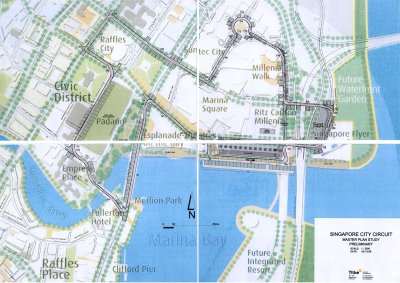A minor controversy has erupted over the girls appearing on the New Paper... apparently the sticking point is that Shireen says that she did 240 kmh
-1 on Sepang, while some guys totally write off the claim, and using some unkind words to the effect. e.g. "bullshit", "my foot" etc
Ignoring driver ability, let's do some quick calculations to see whether it's really possible to do 240 kmh
-1 at SIC.
Based on personal experience and datalogs corroborated with 3rd parties, a realistic corner exit speed out of T15 is about 80 kmh
-1. The Sepang website gives the longest straight into T1 at 927.543 meters. Let's just say 925 m for the sake of simplicity. Let's also assume that the driver intends to make T1 safely* and so let's pick an arbitrary but reasonable braking point at 150 m, giving 775 m as the available distance for acceleration.
From these figures, a car needs about 17.5 seconds at full acceleration to go from 80 kmh
-1 to 240 kmh
-1, given a distance of 775 m, or an acceleration rate of 2.55 ms
-2. About 0.26 G's.
How fast does 0.26 G's feel? About as fast as a 270 whp Evo in 4th gear, which is not fast at all. I'm sure many of you have sat in vehicles that accelerate in top gear about as hard as a stock Evo in 3rd or even 2nd. Now those are real monsters.
Besides, I'm assuming the vehicle is a full-weight street car on street-legal tires. Hell even I'm getting a V
max of around 225 kmh
-1 when my underpowered car's driven in anger.
There's no doubt that a 240 kmh
-1 V
max is definitely possible.
In closing we should avoid making sweeping statements and hasty generalizations without having an appreciation of what it really takes to accomplish certain objectives or we might be branded as jealous, jaded, bitter old men, reminiscing about the times when "real men" didn't have electronics to help in the driving. But that's another blog entry. Heh.
* Since peak velocity is the focus, no mention is made about lap times. It is very likely that peak velocity can be achieved but the vehicle may not be settled enough to take T1 at the traction limit, resulting in lower segment times but possibly overall higher lap times.
Quick proof: T1 can be taken at 80 kmh-1, which means the car has to brake at 13.17 ms-2 or about 1.34 G's.Update: I'm grateful to Shaun for pointing out some flaws. I have since gone through the calculations and found an error in calculating the deceleration forces.As for the braking aspect, here I made a major boo-boo. Reviewing my datalogs, deceleration from 215 kmh
-1 to about 80 kmh
-1 of 1.07G was achieved using the standard Brembo calipers and rotors, Ferodo DS2500 pads, RE070 tires and stock suspension. The car travelled a distance of 134.1m while all this is happening. Unfortunately I lack data on aftermarket brake and suspension setups to get an idea of what sort of deceleration forces are possible.
Just for the sake of the discussion, let's assume a 1.07G decelerative force applies; that means the car actually needs to brake at the 188m marker to make the corner, which means the available distance to accelerate should be reduced by 188-150 = 38m. This would mean that acceleration would need to be 0.27G's to make up for the shorter distance.
Comments and critique welcome as always.
 Seems that the motorsport world is abuzz with talk about a new F1 track in Singapore.
Seems that the motorsport world is abuzz with talk about a new F1 track in Singapore.